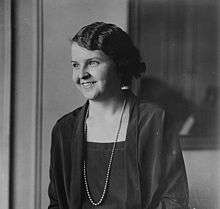Marion Talley

Marion Nevada Talley (December 20, 1906 – January 3, 1983)[1] was an American opera coloratura soprano. In 1926, she was the youngest prima donna to have made a debut at the Metropolitan Opera, but her swift rise to fame was followed by a relatively quick return to obscurity.
Early life
Talley was born in Nevada, Missouri, the daughter of a telegraph operator for Missouri Pacific Railroad. She grew up in Kansas City, Missouri after her father was transferred there when she was a baby. At an early age she was taking piano, violin, and voice lessons, singing with church choirs, and growing a reputation among local music critics and audiences.
At the age of fifteen, Talley appeared in a 1922 Kansas City Grand Opera Company production of Mignon by Ambroise Thomas, and was a local sensation. Her career became a cause célèbre for the citizens of Kansas City, who attended benefit concerts and contributed money for her to study in New York, under the famed teacher Frank LaForge, and later in Italy. She unsuccessfully auditioned for the Metropolitan Opera in 1923.[2][3]
Career
The Metropolitan Opera's general manager, Giulio Gatti-Casazza, hired Talley for the 1925/26 season. On February 17, 1926, she made her debut there as Gilda, the daughter of the title character in Giuseppe Verdi's Rigoletto. At the age of nineteen, she was the youngest prima donna to sing at the Metropolitan Opera at that time.[2][3] (Patrice Munsel would perform there at age eighteen in 1943.) Her pending debut caused a media sensation, contrary to Gatti-Casazza's hopes that it would remain low-key. A delegation of two hundred leading citizens of Kansas City, including Mayor Albert I. Beach, arrived via a special train. Tickets were being resold at astronomical prices. A telegraph was set up backstage so her father could send dispatches to the Associated Press. Her performance prompted multiple ovations from the crowd, but critics were less enthusiastic. While they thought her debut promising, it did not live up to the expectations caused by the media frenzy.[2][3][4][5]
That year featured two other Talley debuts.Two days later, she made her radio premiere singing "Home! Sweet Home!"[4] She also appeared in the first publicly exhibited shorts featuring the Vitaphone sound film, which premiered on Broadway on August 6, along with the first Vitaphone feature-length film, Don Juan starring John Barrymore. The short films preceding the feature were a collection of musical performances featuring Talley along with a number of other classical and opera musicians including Henry Hadley conducting the New York Philharmonic, Mischa Elman, Josef Bonime, Efrem Zimbalist, Harold Bauer, Giovanni Martinelli, and Anna Case and Hawaiian guitarist Roy Smeck. Talley performed "Caro nome" from Rigoletto. Negative reviews of the Vitaphone premiere focused mainly on Talley, criticizing her inexperience as a performer and her lack of photogenic qualities. In 1927, she would appear in another Vitaphone short film, performing "Bella figlia dell'amore", the quartet from Rigoletto. along with Jeanne Gordon, Beniamino Gigli, and Giuseppe de Luca.[6][7][8]
Talley spent four seasons with the Metropolitan Opera and appeared in only seven productions, for a total of eighty-four performances. Her roles included the Queen of the Night in The Magic Flute by Wolfgang Amadeus Mozart, the title character in Lucia di Lammermoor by Gaetano Donizetti, and the title character in Le Rossignol by Igor Stravinsky. Her contract was not renewed for the 1929 season.[2][3]
Later life and marriages
Talley claimed that she would retire to a farm in Kansas, but she attempted to resurrect her career in several ways. She went on concert tours and spent some time at the Chicago Opera. From 1936-1938, she had her own program on NBC Radio. It was sponsored by Ry-Krisp and she appeared in many of their advertisements. She moved to Los Angeles to pursue a career in motion pictures, but she starred in only one film, Follow Your Heart (1936), a musical from Republic Pictures. Soon she permanently retired from show business.[2][3][9]
Talley was married twice. In 1932, she married German pianst Michael Raucheisen, but the marriage was annulled after a few months.[10] In 1935, she married music critic Adolf Eckstrom. That marriage ended with a lengthy custody battle over their daughter Susan. Both marriages received much media publicity.[2][3]
References
- ↑ "Marion Talley." Baker's Biographical Dictionary of Musicians. New York: Schirmer, 2001. Biography In Context. Web. 18 July 2013.
- 1 2 3 4 5 6 Twomey, Alfred E. (1999). "Talley, Marion". In Lawrence O. Christensen. Dictionary of Missouri Biography. University of Missouri Press. p. 739. ISBN 978-0-8262-6016-1.
- 1 2 3 4 5 6 Lewis, Uncle Dave. "Marion Talley: Artist Biography". AllMusic. Retrieved 18 July 2013.
- 1 2 "Debut". Time. 7 (9): 19–20. March 1926.
- ↑ "Talley Finale". Time. 13 (16): 60. 22 April 1929.
- ↑ Richard Koszarski (2008). Hollywood On the Hudson: Film and Television in New York from Griffith to Sarnoff. Rutgers University Press. pp. 149–51. ISBN 978-0-8135-4293-5.
- ↑ Barrios, Richard (1995). A Song in the Dark: The Birth of the Musical Film. Oxford University Press. pp. 20–29. ISBN 978-0-19-508811-3.
- ↑ Donald Crafton (1999). The Talkies: American Cinema's Transition to Sound, 1926-1931. University of California Press. pp. 71–78. ISBN 978-0-520-22128-4.
- ↑ John Dunning (19 March 1998). On the Air:The Encyclopedia of Old-Time Radio. Oxford University Press. p. 438. ISBN 978-0-19-984045-8.
- ↑ "Miss Talley Freed of Martial Bonds: Annulment Granted in West on Ground Raucheisen Barred Her Relatives. Married Six Months Ago, Retired Young Singer Began Her Meteoric Career With Debut at the Metropolitan in 1926". The New York Times. 29 January 1933. p. 10.
External links
- Marion Talley at the Internet Movie Database
- Marion Talley at Find a Grave
- Caro Nome (1926) on YouTube
- Rigoletto Quartet (1927) on YouTube